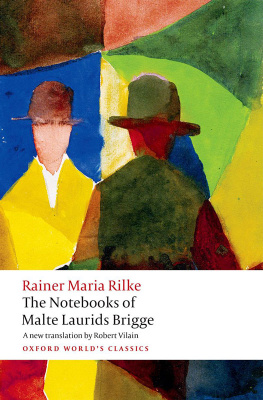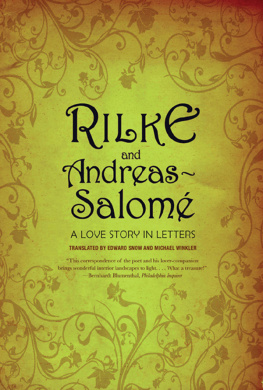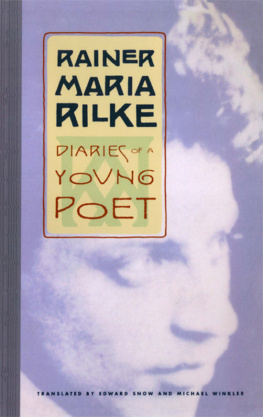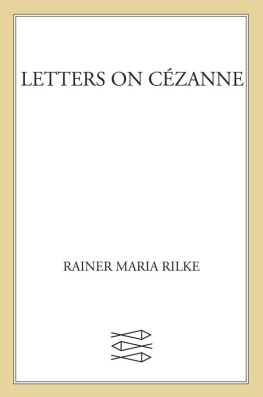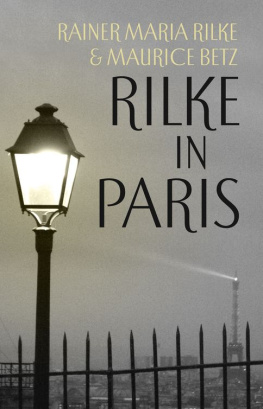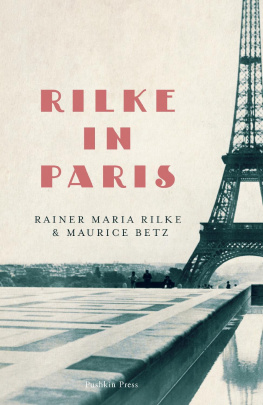Rainer Maria Rilke - Letters of Rainer Maria Rilke, 1892-1910
Here you can read online Rainer Maria Rilke - Letters of Rainer Maria Rilke, 1892-1910 full text of the book (entire story) in english for free. Download pdf and epub, get meaning, cover and reviews about this ebook. year: 2014, publisher: W. W. Norton & Company, genre: Romance novel. Description of the work, (preface) as well as reviews are available. Best literature library LitArk.com created for fans of good reading and offers a wide selection of genres:
Romance novel
Science fiction
Adventure
Detective
Science
History
Home and family
Prose
Art
Politics
Computer
Non-fiction
Religion
Business
Children
Humor
Choose a favorite category and find really read worthwhile books. Enjoy immersion in the world of imagination, feel the emotions of the characters or learn something new for yourself, make an fascinating discovery.
- Book:Letters of Rainer Maria Rilke, 1892-1910
- Author:
- Publisher:W. W. Norton & Company
- Genre:
- Year:2014
- Rating:4 / 5
- Favourites:Add to favourites
- Your mark:
- 80
- 1
- 2
- 3
- 4
- 5
Letters of Rainer Maria Rilke, 1892-1910: summary, description and annotation
We offer to read an annotation, description, summary or preface (depends on what the author of the book "Letters of Rainer Maria Rilke, 1892-1910" wrote himself). If you haven't found the necessary information about the book — write in the comments, we will try to find it.
Rainer Maria Rilke: author's other books
Who wrote Letters of Rainer Maria Rilke, 1892-1910? Find out the surname, the name of the author of the book and a list of all author's works by series.
Letters of Rainer Maria Rilke, 1892-1910 — read online for free the complete book (whole text) full work
Below is the text of the book, divided by pages. System saving the place of the last page read, allows you to conveniently read the book "Letters of Rainer Maria Rilke, 1892-1910" online for free, without having to search again every time where you left off. Put a bookmark, and you can go to the page where you finished reading at any time.
Font size:
Interval:
Bookmark:
RAINER MARIA RILKE
In Translations by M. D. H ERTER N ORTON
Letters to a Young Poet
Sonnets to Orpheus
Wartime Letters of Rainer Maria Rilke
Translations from the Poetry of Rainer Maria Rilke
The Lay of the Love and Death of Cornet Christopher Rilke
The Notebooks of Malte Laurids Brigge
Stories of God
Translated by S TEPHEN S PENDER and J. B. L EISHMAN
Duino Elegies
Translated by J ANE B ANNARD G REENE and M. D. H ERTER N ORTON
Letters of Rainer Maria Rilke
Volume One, 18921910 Volume Two, 19101926
R ILKE was born in Prague in 1875, the son of a conventional army-officer father and a religious-fanatical mother, who first sent him, most unsuitably, to military school. After that, largely autodidact, he studied philosophy, history, literature, art, in Prague, Munich, Berlin. From his earliest years he wrote verse. In the 90s both Erste and Frhe Gedichte appeared, short stories, plays. Much of his early work he declined to include in his collected works. In 1899 (which saw the Cornet, first version) came the first of two trips to Russia with Lou Andreas-Salom (Vom lieben Gott und Anderes, later to be called Geschichten vom Lieben Gott, appeared in December 1900). He married Clara Westhoff in 1901, lived in Worpswede till the birth of their only child, Ruth, moving to Paris in 1902, Clara to work with Rodin, Rilke to write his monograph on him. Between travels in Germany, France, Italy, Spain, Egypt, Scandinavia, and his prodigious letter-writing, the twelve years with Paris as base were productive: Stundenbuch, Buch der Bilder, Neue Gedichte, Notebooks of M. L. Brigge, translations of E. B. Browning, Gide, de Gurin. After the outbreak of World War I he lived mostly in Munich, served briefly in army office work in Vienna, and in 1919 went to Switzerland. Here, in the small stone tower of Muzot, he achieved in 1922 the Duineser Elegien and the Sonette an Orpheus, followed by poems in French and translations of Valry and others. He died at Valmont near Glion on December 29, 1926, and is buried beside the little church of Raron overlooking the Rhone Valley.
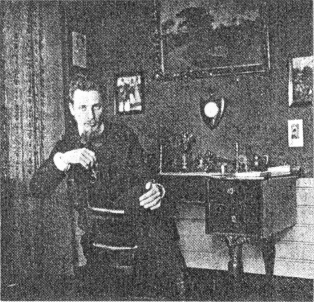
In the Living Room of the Westerwede House 1902
RAINER MARIA RILKE
1892 1910

Translated by
JANE BANNARD GREENE
and
M. D. HERTER NORTON


The Norton Library
W W NORTON & COMPANY INC
NEW YORK
CONTENTS
ILLUSTRATIONS
IN THE LIVING ROOM OF THE WESTERWEDE HOUSE (1902)
From Rainer Maria Rilke by Lou Andreas-Salom
FACSIMILE OF LETTER TO HUGO VON HOFMANNSTHAL
Reproduced from that in the first edition of the Briefe
FACSIMILE OF LETTER TO DR. MARTIN ZICKEL
From the collection of Richard von Mises, Cambridge, Mass.
U NLESS otherwise indicated in the Notes, all these letters have been taken from the two editions of the general collection of Rilkes Letters, edited by his daughter and son-in-law, Ruth Sieber-Rilke and Carl Sieber, and published by Insel-Verlag, which differ not greatly yet enough to make them complementary.
Our thanks go to Richard von Mises, of Harvard University and the Massachusetts Institute of Technology, for his generous interest and help, and to Paul Graham, of Smith College, who kindly read much of the text.
We owe particular gratitude to Herbert Steiner, formerly editor of Corona, who has been for us a keen critic in the larger sense, giving many patient hours to discussion of difficult passages in the translation, and allowing us to draw for guidance in points of interpretation upon his knowledge of the background of Rilkes life and creative activity.
M ANY of the letters in Rilkes extraordinary correspondence have an artistic validity of their own and are to be enjoyed for themselves, even by one unacquainted with his poetry or with his life. While the letters in this volume have been chosen principally for their intrinsic beauty or wisdom, others have been included because they are psychologically revealing in a more personal sense, or because, like those of the very young Rilke, they contain a first statement of characteristic themes, or because they give the continuity that helps to make of the collection a kind of spiritual autobiography. To piece together a complete biographical story would not have been possible at this time. Rilke made it clear in his will that since a part of his creative energy had gone into his letters there would be no objection to their being published; but many people who were closest to him are still alive and much of a personal nature has inevitably been left out of the two editions of the Letters, prepared by his daughter and son-in-law, which still remain the principal source we have to draw on.
Both in his life and in his artistic development, 1910, when he had finished the Notebooks of Malte Laurids Brigge, offers a logical year in which to close this first of two volumes of Rilkes letters. The period from his seventeenth year until this time embraces all the great experiences of his early adult life, and these, save for his friendship with Lou Andreas-Salom which was lifelong, were rounded out by now or just entering upon a new phase. Russia no longer dominated his conscious thinking but had become embedded, as he was to put it, in the substructure of his life; there are later few letters to his wife, the sculptress Clara Westhoff, to whom so many of the present pages are addressed; Paris, with which he had wrestled so desperately, had become the stern but benevolent guardian of his work; the overwhelming impact of Rodins art and personality had passed over the rapids and come down to a quiet stream, and he had made his discovery of Czanne and his paintings. With all this, the springs of his own inspiration, while they did not go dry, seemed to disappear underground; he became prey to a distressing inner restlessness that was to outlast even the war years and not again be overcome by the great flow of his creative genius until 1922, the year of the Duino Elegies and the Sonnets to Orpheus.
These strands of experience wove significant patterns in the poets art. In reality, he wrote in 1899, one seeks in everything new (country or person or thing) only an expression to help some personal confession to greater power or maturity. All things are there in order that they may become pictures for us. So Russia gave him pictures for the Stories of God, the Book of Pictures, and the Book of Hours; Paris gave him pictures (many of them painful) for the Book of Pictures, the third part of the Book of Hours, the New Poems, and the Notebooks.
Only his approach to the pictures changed. Nature, he had written of the time before he met Rodin, was still a general stimulation for me, an evocation, an instrument on whose strings my fingers found themselves again; I did not sit before her; I let myself be carried away by the soul that went out of me; she came over me with her great immense existence, as prophecy came over Saul, just that way. I went along with her and saw, not Nature, but the faces she inspired in me. Already in his contact with the Worpswede painters he had been made aware of a different relationship to Nature, this daily attentiveness, alertness, and readiness of the out-turned senses, this thousandfold looking and always looking away from oneself this being-only-eye, as he noted in his journal. Rodin too believed in looking, observing, seeing, in drinking things in with his eyes and letting them speak for themselvesin a word, in objectivity. This Rilke set himself to learn in his own field, and the effort involved in fixing his attention on an external object, in keeping the music within him so muted that, as it were, the thing itself could speak and be heard, proved to be a rigorous discipline for himself and his art. The
Font size:
Interval:
Bookmark:
Similar books «Letters of Rainer Maria Rilke, 1892-1910»
Look at similar books to Letters of Rainer Maria Rilke, 1892-1910. We have selected literature similar in name and meaning in the hope of providing readers with more options to find new, interesting, not yet read works.
Discussion, reviews of the book Letters of Rainer Maria Rilke, 1892-1910 and just readers' own opinions. Leave your comments, write what you think about the work, its meaning or the main characters. Specify what exactly you liked and what you didn't like, and why you think so.


